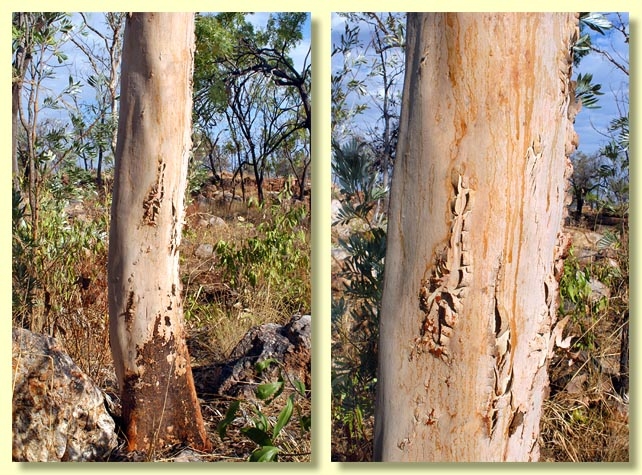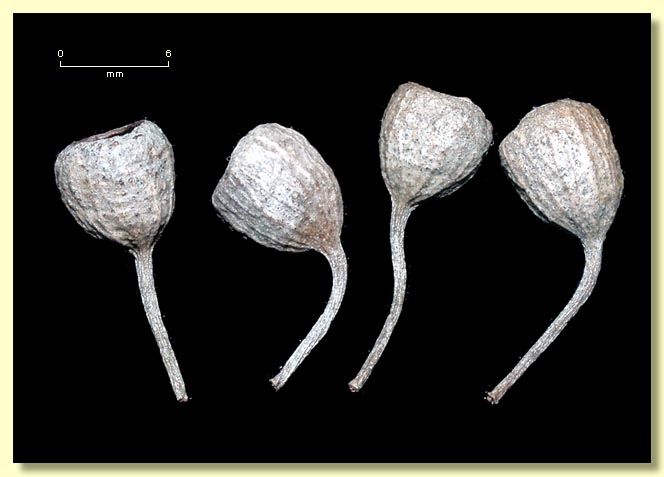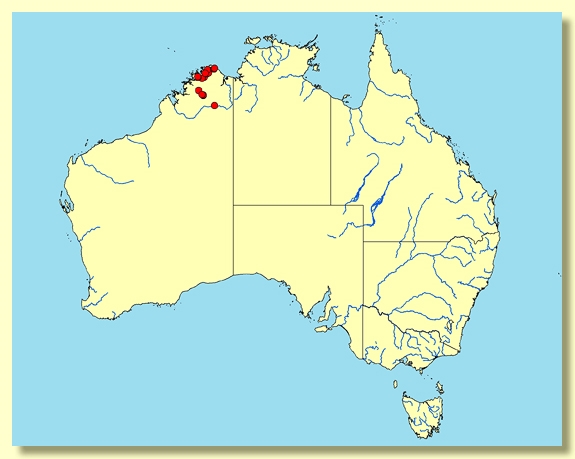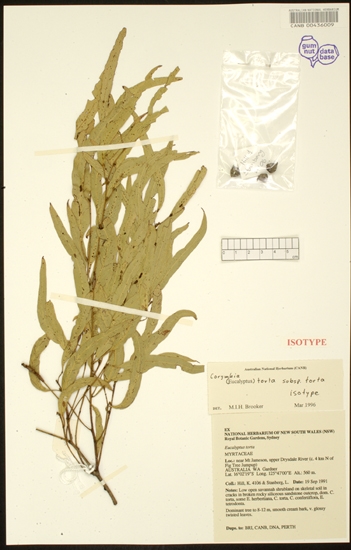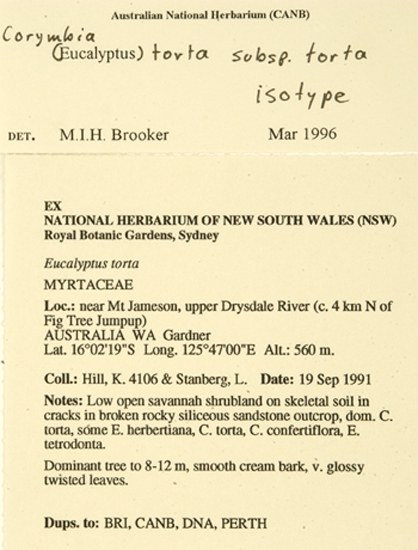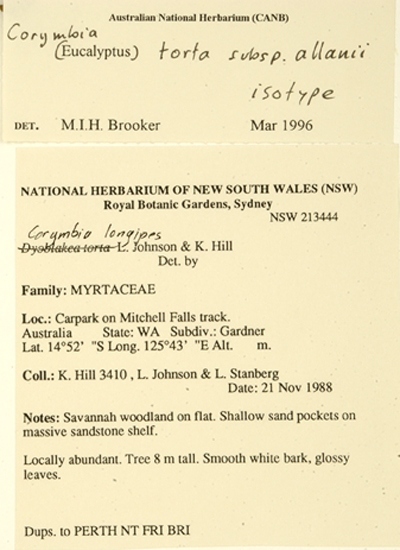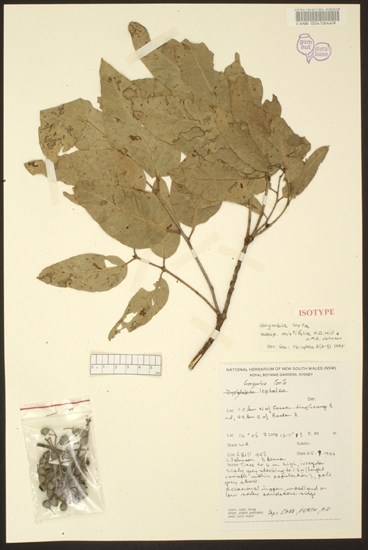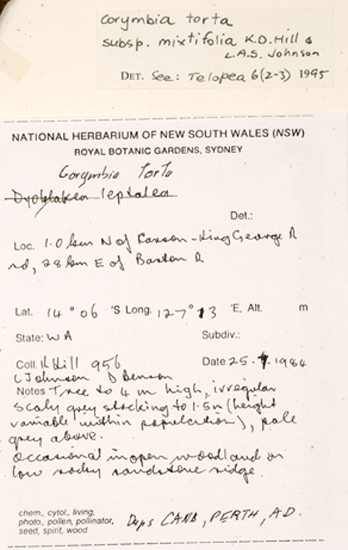Corymbia | Blakearia
Euclid - Online edition
Corymbia torta
Corymbia torta K.D.Hill & L.A.S.Johnson, Telopea 6: 418 (1995).
Tree to ca 15 m tall. Forming a lignotuber.
Bark smooth throughout, sometimes powdery, white or cream to very pale grey or pink-orange.
Branchlets lack oil glands in the pith; smooth.
Juvenile growth (coppice or field seedlings to 50 cm): not seen.
Adult leaves alternate, petiolate, petioles 0.5–2.2 cm long; blade lanceolate, 7–17.5 cm long, 0.7–2.5(4.5) cm wide, undulate and twisted, base tapering to petiole, apex pointed, margin entire, concolorous, glossy, green, smooth, side-veins about 45° to midrib, reticulation dense to very dense, intramarginal vein present, oil glands obscure.
Inflorescence axillary compound, condensed, the rhachis usually with only the basal internode obvious, 0.1–0.5 cm long, peduncles usually very short, ca 0–0.5(1.4) cm long, buds 3 or 7 per umbel, pedicels 0.2–0.7 cm long. Mature buds pyriform to globular, 0.5–0.6 cm long, 0.3–0.4 cm wide, surface smooth and glossy, scar present (outer operculum shed during bud development), operculum rounded to flattened, stamens inflexed, all fertile, anthers oblong, dorsifixed, versatile, dehiscing by longitudinal slits, style long and straight, stigma tapering, locules 3, the placentae each with ovules arranged in ± 3 or 5 vertical rows or the rows indistinct. Flowers creamy white.
Fruit pedicellate (pedicels 0.2–1 cm long), cupular to cylindrical or barrel-shaped, 0.6–0.9 cm long, 0.5–0.9 cm wide, thin-walled, smooth, disc descending vertically, valves 3, enclosed.
Seeds not seen (presumably brown, saucer-shaped, smooth on both surfaces, hilum ventral, like other ghost gums).
Cultivated seedlings (measured at ca node 10): not grown.
Flowering has been recorded in November.
A ghost gum tree endemic to the Kimberley region of Western Australia from the King Leopold Range north to the Mitchell Plateau, and west to Theda station and Drysdale River National Park. Corymbia torta occurs on sandstone plateaus, and has an essentially smooth trunk, seasonally powdery to touch, whilst the crown is composed of alternate, petiolate, glossy, green, lanceolate leaves twisted or undulate. Buds are small, being only ca 0.5–0.6 cm long, 0.3–0.4 cm wide at maturity, and fruit are cupular to barrel-shaped, 0.5–0.9 cm wide.
The species was named by Hill & Johnson (1995) in their revision of the bloodwoods and ghost gums, as Corymbia torta, i.e. in genus Corymbia section Blakearia (the ghost gums), where they allied it with C. polysciada, a species endemic of the Top End of the Northern Territory. In their field guide Brooker & Kleinig (2004) include populations of this ghost gum in Eucalyptus aparrerinja . In "Flora of the Kimberley region" (Wheeler et al, 1992, p. 529) it is treated as Eucalyptus species F.
Hill & Johnson (1995) divided C. torta into three subspecies as follows, distinguished primarily on floral characters that have been very rarely collected. These subspecies are so poorly known from specimens that their inclusion in EUCLID is problematic. The following infraspecific information is largely a synopsis from Hill & Johnson (1995):
subsp. torta
Distinguished by having short pedicels, less than or equal to 0.7 cm, and “the more rapid development of the adult foliage”. Found on Mount Elizabeth and Mount Barnett Stations, and the Elgee Cliffs area. Plants collected by the EUCLID team from Mount Elizabeth station and Theda station match this taxon in habit, crown and fruit features.
subsp. allanii (after colonial botanist Allan Cunningham, who collected a specimen, his number 453, in October 1819, from Vansittart Bay.)
Distinguished by pedicels > 0.7 cm, short peduncles 0–0.5 cm long and “the tendency to retain intermediate foliage in the canopy”. Found from northern edges of Mitchell Plateau, Carson River area and to the south-west of Kalumburu.
subsp. mixtifolia (from Latin mixtus meaning mixed, and folia, meaning leaves referring to the crown of mixed intermediate and adult leaves).
Distinguished by pedicels 0.7–1.0 cm long and peduncles (0.3)0.7–1.4 cm long combined with retention of intermediate foliage in the crown. Known only from north-east of Kalumburu in an area difficult of access.
C. torta seems closely related to the central Australian ghost gum C. aparrerinja rather than C. polysciada, being predominantly smooth-barked and having a condensed inflorescence with only the basal internode well developed, and fully adult leaves, whereas C. polysciada has the basal and often a second internode developed in the inflorescence as well as having conspicuously tessellated rough bark over part of the trunk. The placement of C. torta in Corymbia series Polysciadae by Hill & Johnson (1995) seems erroneous. C. torta deserves further study to elucidate its relationships and to study variation and infraspecific classification. Whilst frequently seen for many decades by many botanists visiting this area, C. torta remains poorly known, and rarely collected in other than the sterile state, despite the fact that it seems to flower before the onset of the Kimberley wet season in December.
MORE ABOUT CORYMBIA
MORE ABOUT GHOST GUMS


